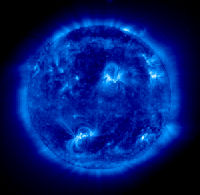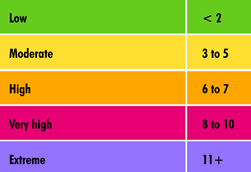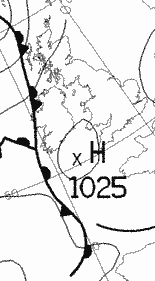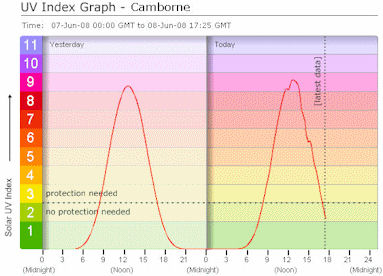|
|
|
Ultraviolet
light is emitted by the sun and forms part of the electromagnetic spectrum, of
which visible light is included. See the diagram above for the full range of the
electromagnetic spectrum that has radio waves (longer waves), going through to
the shorter wavelength (more energetic) Gamma and Cosmic rays. |
|
You can see that
UV light falls to the left of visible light, therefore each photon contains more
energy than say, infrared.
Apart from the
border with visible light, UV is invisible to our eyes and covers the
wavelengths from 10 nanometres (nm) to 400 nm, and energies from 3 electron
volts (eV) to 124 eV.
Nearly all of
the UV in sunlight is blocked by the ozone layer, and a good job too as this
prevents the shorter wavelengths of UV (and hence most damaging) from reaching
the ground. |
 |
|
The sun's disc
in UV light |
|
Ultraviolet radiation has been
designated as three types: UVA, UVB, and UVC. The most energetic is UVC and this
is responsible for the formation of ozone in the atmosphere and hence, does not
reach the earth's surface. |
|
What remains of the UV in sunlight,
i.e., UVA & UVB (some below 280
nm, and most below 315 nm) penetrates down to the earth's surface. Both types of
UV can give a suntan, though UVB is responsible for the deeper, darker,
longer-lasting tan. People have evolved this ability to 'tan' over 1000s of
years, and it is this tan that can help to reduce the damaging effects that UV
can have on our skin. |
|
As a way of giving a forecast of
the potential UV strength of sunlight, the UV Index (UVI) was created. This
originally was on a scale of 1 to 10, with 1 being minimal strength and 10 being
extreme. It was found that UV does exceed the original scale and now UVI levels
of 11 or more can be given. The way how UVI is calculated is complex but the
scale is linear and can be divided into the following for guidance: |
 |
How you respond
(sunburn) to the UVI when out in the sunshine will depend on the colour of your
skin, with lighter skin burning quicker than darker skin. Also, your skin will
adapt to exposure over a longer period of time so you can build up a resistance
(suntan) that will allow you to stay out longer in the sunshine before you get
sunburnt. In the British Isles, the strongest sunshine is along the south and
south-west coasts, and it is these places that also get the most sunshine
duration. Here in the Otter Valley, sunburn is a real risk from mid-March until
early October with severe sunburn possible from mid-April until mid-September. |
|
Jan |
Feb |
Mar |
Apr |
May |
Jun |
Jul |
Aug |
Sep |
Oct |
Nov |
Dec |
|
1 |
2 |
2 |
3 |
3 |
4 |
5 |
6 |
6 |
7 |
7 |
8 |
8 |
8 |
8 |
7 |
6 |
5 |
4 |
3 |
3 |
2 |
2 |
1 |
|
Typical maximum UVI values
for here in the Otter Valley throughout the year |
|
 |
Weather
conditions can prevail that cause extreme UV levels. These high levels
can occur anytime from mid-May to early August, i.e., when the sun is
60° or above in elevation. Such an event occurred on the 8th June
2008 and can be seen in the HPA graph on the right. In 2011, UVI 9
occurred on the 6th June & the 6th July. UV levels were very high at
times during 2014 with UVI 9 being exceeded on 8 days and a maximum UVI
of 10.0 being recorded on the 14th July 2014. |
 |
|
Met
Office UK Chart 8th June 2008 |
HPA
Graph of the UVI at Camborne, Cornwall on the 7th & 8th June 2008. It
shows the UV peaking at over 9 on both days. |
|
|
|
|
The highest UVI levels generally
occur in maritime tropical air during May, June, July and early August. A
partially cloudy sky with the sun shining will often add 1 to the UVI due to
reflection off the clouds. Reflection off the sea and sand on south facing
beaches could also add another 1 or 2 to the UVI, often giving our south coast
beaches of Devon & Cornwall the highest UVI found in the British Isles. |
Here are a few interesting facts
about UV:
 |
The higher the sun in the
sky, the higher the UV level. Therefore, UV levels vary with time of day
and time of year. Outside of the tropics, the highest levels occur when
the sun is at its maximum elevation, at around midday (solar noon)
during the summer months. Here in the Otter Valley that occurs at around
13:15. |
 |
At higher altitudes, a
thinner atmosphere absorbs less UV radiation. With every 1000 metres
increase in altitude, UV radiation levels increase by 10% to 12%. |
 |
Ozone absorbs most of the
UV radiation that would otherwise reach the Earth’s surface. Ozone
levels vary over the year and even across the day. |
 |
UV radiation is reflected
or scattered to varying extents by different surfaces, e.g. fresh snow
can reflect as much as 80% of UV radiation, dry beach sand about 15% and
sea foam about 25%. |
|
|
Home |
Data |
Live |
Webcam |
Station |
Climate |
Gallery |
Contact
|
Links |

